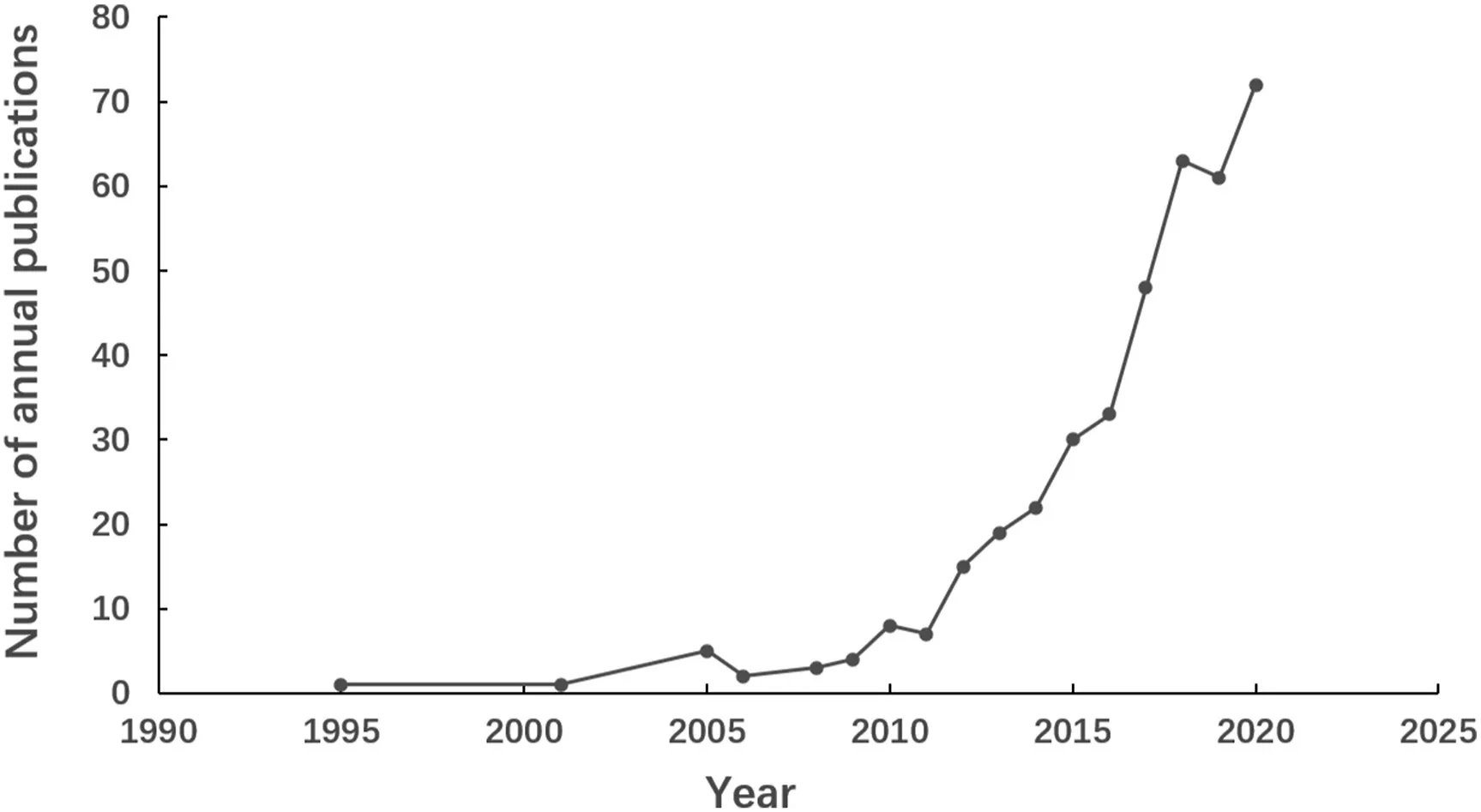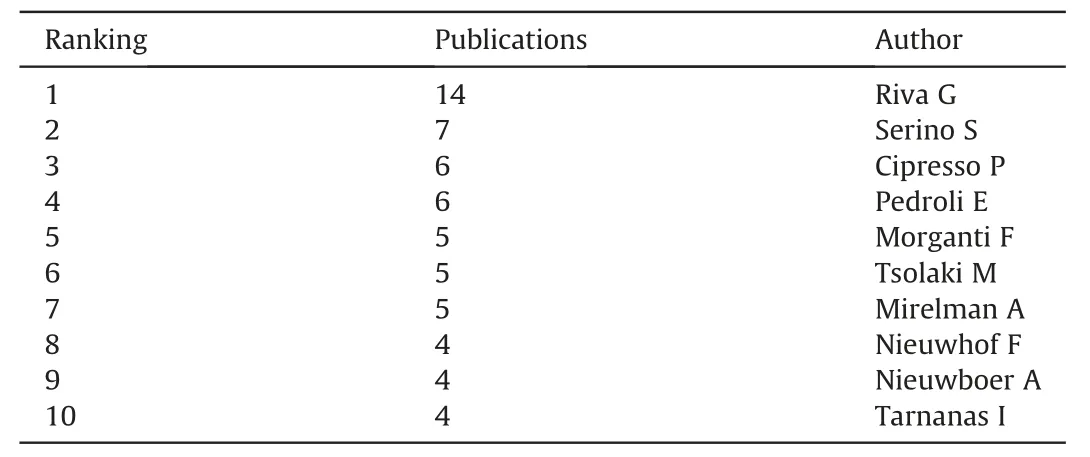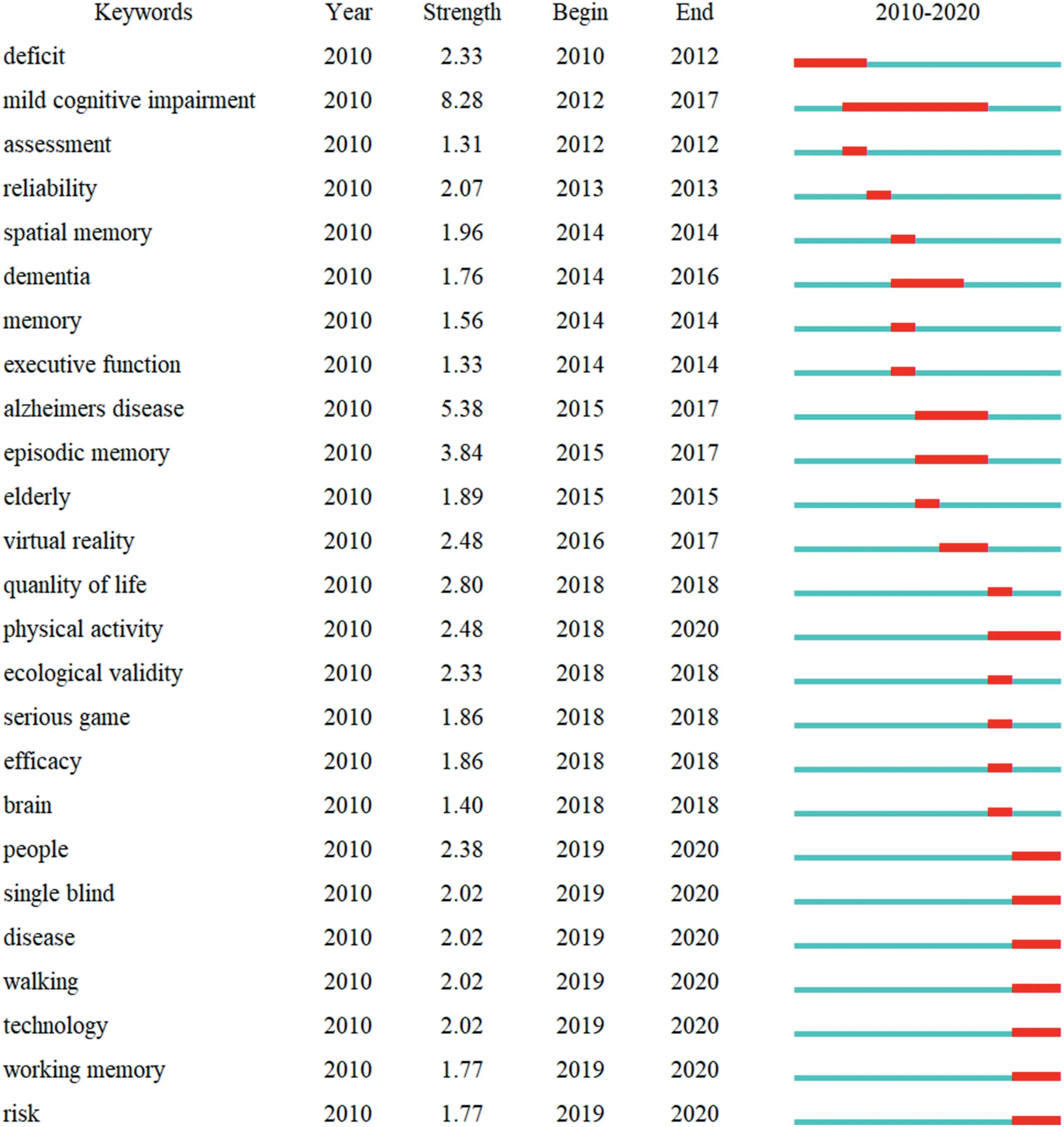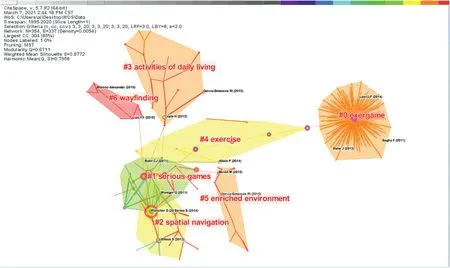Study of virtual reality for mild cognitive impairment: A bibliometric analysis using CiteSpace
Kiyn Zhu , Rong Lin ,b, Hong Li ,b,*
a The School of Nursing, Fujian Medical University, Fuzhou, China
b Research Center for Nursing Theory and Practice, Fujian Provincial Hospital, Fuzhou, China
Keywords:Bibliometrics Cognitive dysfunction Dementia prevention Exercise therapy Mild cognitive impairment Virtual reality
ABSTRACT Objectives: Non-invasive and low-cost virtual reality (VR) technology is important for early evaluation and intervention in mild cognitive impairment(MCI).This study aimed to demonstrate the current status of overseas and domestic research as well as the focus and frontier of VR technology among individuals with MCI through a bibliometric analysis.Methods: Studies from the core collection of Web of Science™between 1995 and 2020 were used;furthermore, CiteSpace 5.7 R3 was utilized to analyse information on authors/cited authors, keywords,burst words, and cited references.Results: In total, 230 publications were identified.Most studies were published in the USA (45 publications) and Italy (41 publications), where Guiseppe Riva ranks first (14 publications), and Tarnanas I is the author with the highest centrality(0.44).The hot topics in VR applications in the MCI population are‘physical activity,’‘people,’‘single-blind,’‘disease,’‘walking,’‘technology,’‘working memory,’and‘risk’in recent years.The keyword ‘mild cognitive impairment’ has attracted extensive attention since 2012,showing the strongest citation outbreak(8.28).The clustering results of the literature show the research types and emerging trends, including ‘exergame,’ ‘serious games,’ ‘spatial navigation,’ ‘activities of daily living,’ ‘exercise,’ ‘enriched environment’ and ‘wayfinding.‘Conclusions: Cognitive assessment and nonpharmacological intervention research on patients with MCI have become the focus of dementia prevention in recent years.Virtual technology, combined with traditional methods such as exercise therapy,provides new ideas for innovative cognitive evaluation and cognitive intervention.
What is known?
· With the rapid development of computer technology, virtual reality technology provides advanced technical support for innovating the methods of early cognitive assessment and intervention for patients with mild cognitive impairment.
What is new?
· We used CiteSpace software for visual bibliometric analysis.Through this analysis, we can understand the most influential authors, literature, research hotspots and future research directions in the field of virtual reality and mild cognitive impairment.
1.Introduction
With the increasing trend of population aging, the number of elderly people with dementia is increasing each year.It is estimated that by 2050,the number of dementia patients in the United States will exceed 13.8 million.These increases will have a marked impact on the healthcare system.Mild cognitive impairment (MCI) is a grey area between normal cognitive aging and dementia.According to the 2018 American Academy of Neurology updated guideline,the incidence rates of MCI were 6.7%, 8.4%,10.1%,14.8%, and 25.2% for those aged 60-64, 65-69, 70-74, 75-79, and 80-84 years,respectively [1].These individuals have a tenfold greater risk of progression to dementia than the normal elderly population [2,3].Early cognitive management for patients with MCI not only slows or reverses the downward trend from MCI to dementia but also reduces health care expenditure.
Virtual reality (VR) is a computer-generated effect that can simulate a given scene in the real world through three-dimensional(3D) graphics and other sensory experiences (vision, touch, and motion feeling).Users can interact with such virtual environments through special electronic devices [4].VR application in the cognitive management of MCI patients remains a topic under research.A study developed the virtual supermarket, which had a correct classification rate (CCR) of 87.3% in distinguishing MCI patients from healthy people [5].Researchers considered that VR might be more ecologically effective than a paper and pencil or computer evaluation because participants can navigate in the virtual scene from a 3D 360°‘first-person’ perspective [6].Moreover,the interactivity of VR allows patients to interact with characters/scenes in the virtual environment through different interactive devices and to obtain timely feedback.For example, VR intervention,based on visual feedback,enables patients to see their actions and to constantly adjust their position in the virtual scene [7,8].Patient satisfaction surveys show that compared with the traditional paper and pen intervention, VR cognitive intervention is more attractive to older adults [9,10].Therefore, VR is a promising tool for neuropsychological assessment and cognitive intervention.
Bibliometrics is a common analysis method for evaluating or quantifying research literature and information.CiteSpace software is a web-based Java application developed in 2004 by Professor Chaomei Chen for exploring the trends and patterns in a knowledge domain[11].CiteSpace involves three core metrics:burst detection,betweenness centrality, and heterogeneous networks.These metrics are useful for describing the nature of a research front,detecting existing scientific schools and academic networks, and identifying emerging research fronts and abrupt changes.One study examined 21,167 worldwide literature about VR from 1970 to 2018, analysing these materials and evaluating VR development trends and future research directions [12].Studies on VR application in MCI patients have been published worldwide.However,no research has gathered systematic data on this global scientific output yet.Therefore, it is necessary to make sense of the ballooning information in this research field by visualised analysis.Accordingly,we aimed to investigate the current status of overseas and domestic research as well as the focus and frontier of VR technology through a bibliometric analysis among individuals with MCI.
2.Material and methods
2.1.Data collection
This research involved the core collection materials of the Science Citation Database(Web of Science),including SCI-EXPANDED,SSCI, A&HCI, CPCI-S, CPCI-SSH, BKCI-S, BKCI-SSH, ESCI, CCREXPANDED, and IC.Advanced retrieval of subject words was adopted.The retrieval formula is as follows:#1 comprised‘virtual reality’ OR ‘3D environment’ OR ‘immersive virtual reality’ OR‘simulated environment’, #2 comprised ‘mid neurocognitive disorder$’ OR ‘mild cognitive improvement$’ OR ‘cognitive improvement$’ OR ‘cognitive improvement$’ OR ‘cognitive disability$’ OR‘cognitive decision$’ OR ‘mental differentiation$’ OR ‘cognition disorder’ OR ‘cognitive dysfunction,’ and for #3, #1, and #2.The first article about the application of VR to the MCI population was published by Pugnetti et al., in 1995.Thus, the time span for the search was from 1995 to 2020 (retrieval date: February 20, 2021).Thus, 394 studies were initially found, including original articles and reviews.After filtering based on the literature exclusion criteria, the dataset was reduced to 230 records, which contained 571 references.
2.2.Inclusion criteria
The inclusion criteria were 1)peer-reviewed published original articles on VR application to the MCI population, including basic and clinical research,2)related reviews,3)articles published from 1995 to 2021, and 4) English articles.
2.3.Exclusion criteria
The exclusion criteria were 1)articles not officially published,2)conference abstracts and proceedings,corrigendum documents,3)repeated publications, and 4) unrelated articles.
2.4.Analysis tool
In recent years,CiteSpace has grown into the most characteristic and influential information visualisation software.CiteSpace is used for bibliometric analysis through a six-step procedure: time slicing, thresholding, modelling, pruning, merging, and mapping[11].The visualisation knowledge network created by CiteSpace comprised nodes and links.Difference items, such as authors,countries, institutions, and cited references, are represented by different nodes.The size of each node indicates the count of literature.High centrality nodes using purple trims represent the turning points or pivotal points in one field.The lines between nodes indicate cooperation or co-occurrence or co-citation relationships:the thicker the line,the tighter the connection[13-16].
The parameters of CiteSpace in this study were as follows:time slicing(1990-2020),years per slice(1),term source(all selections),node type(choose one at a time),selection criteria(top 50 objects),and pruning (pathfinder).To understand the frontiers of VR usage among people with mild cognitive impairment and to examine development trends in the latest research, this study analysed coword networks of keywords.
3.Results
3.1.Publication output
The first paper about VR application for cognitive impairment,‘Evaluation and retraining of adults’ cognitive impairment: which role for virtual reality technology?’, was published in 1995 by Pugnetti et al.[17],which suggests the beginning of VR application in people with cognitive impairment.Since then, publications about VR application in MCI patients have increased persistently.Fig.1 shows the distribution of volume and time regarding these papers.This research was divided into three stages:the embryonic stage(1995-2005),the slow development stage(2005-2011),and the rapid development stage (2011-2020).During the embryonic stage, few studies examined VR use in MCI patients, with the first article published in 1995.During the slow development stage,publications showed a slow-growth trend, with an average of 20 papers being published yearly.During the rapid development stage,the number of publications increased.The year 2020 saw the largest number of publications on related topics (65 articles in total).The statistics for the types of documents showed 131 original articles(56.91%of the total number of articles),including 98 articles in the past five years(75% of the total number of original articles).Additionally, since 1995, there have been 99 reviews overall, most of which were published in 2019.These results indicate that VR,as an emerging auxiliary technology,is receiving increasing attention,and consequently, more research is being conducted.However,compared with other research areas,research on VR application in people with MCI is still nascent.

Fig.1. The number of annual publications on VR application in the MCI population published from 1995 to 2020 in Web of Science.
3.2.Author and co-authorship
Authors play a critical role in promoting scientific development,especially in defining the past, present, and future disciplines in this field [12].There were 547 nodes and 696 links in the author collinear map generated using CiteSpace.Therefore, 230 documents involving 547 authors in total were generated.Table 1 shows the top ten authors who published articles related to the application of VR among MCI populations.These authors were active professionals in this field.Guiseppe Riva, a professor in the Department of Psychology at the Catholic University of Sacred Heart in Italy, published the highest number of such articles (14 articles).His research direction over the past five years has shifted to tapping the potential of VR technologies for assessing early cognitive function among patients with cognitive impairments such as Alzheimer’s disease, MCI, Parkinson’s disease, and posttraumatic cognitive impairment.He considers VR as an innovative and promising neuroscience assessment tool [18-20].In addition,we found that four cooperative groups with five or more cooperating authors.However,the centrality value for such collaborations was 0; this shows that the cooperation relationship between the authors was not close.
An analysis of author co-citations showed that the number of literature citations was directly proportional to the author’scontributions to this field’s development.An author co-citation map was generated, including 125 nodes and 177 links.Table 2 shows the top ten co-cited authors and the top ten authors in terms of centrality value.They can be regarded as influential authors for VR application research in MCI populations.For example,Tarnanas’s recent five-year research focused on applying VR techniques in the early screening of populations with cognitive impairment [21-23].In a study, he used Virtual Reality Day-Out Task (VR-DOT) environments to assess their predictive value for MCI patients;he concluded that virtual technology,which is a noninvasive and low-cost computer cognitive assessment method,could provide additional predictive information[22].Regarding the oriented application of VR technology in cognitive assessment,Plancher’s research was similar to that of Tarnanas,and he focused more on the correlation between VR technology and episodic memory diagnosis [24,25].Optale, Coyle, and others applied VR technology in cognitive interventions for MCI patients.Coyle studied the application of VR cognitive training among MCI patients based on a meta-analysis[26].One of Optale’s studies tested the effects of VR cognitive interventions on memory improvement among older adults and concluded that VR cognitive interventions could improve memory function by enhancing hearing stimulation[27].

Table 1Top 10 authors who published research on VR application among MCI population between 1995 and 2020.
3.3.Co-occurring keywords and burst keywords
A keyword co-occurrence map can reflect the most popular research topic during any given period and burst keywords (keywords that are cited frequently over some time)can forecast future research trends in a given field [14].
A time span from 1995 to 2020 was selected for the analysis,and the top 50 most cited or occurred items from each slice were chosen.A total of 47 co-occurring keywords appeared, reflecting the range of research topics on VR application among MCI patients.An analysis in terms of co-occurrence frequency revealed that the top ten hot keywords were ‘virtual reality,’ ‘Alzheimer's disease,’‘dementia,’ ‘mild cognitive impairment,’ ‘older adult,’ ‘memory,’‘rehabilitation,’ ‘episodic memory,’ ‘cognitive impairment,’ and‘performance.’ (Table 3).
Burst words refer to the keywords,which are cited frequently in a certain period and considered to be indicators of research frontier topics [14].Fig.2 shows the top 25 keywords with the strongest citation bursts between 2010 and 2020.The most recent burst keywords were ‘physical activity,’ ‘people,’ ‘single-blind,’ ‘disease,’‘walking,’ ‘technology,’ ‘working memory,’ and ‘risk.’ The keyword‘mild cognitive impairment,’ showing the strongest citation burst(8.28), emerged from 2012.
3.4.Co-citation analysis
Analysing the document co-citation facilitated our understanding of the current highly cited literature; accordingly, we obtained more influential views and ideas in this field [12].
A co-citation network were generated through the cluster functionality using CiteSpace results (Fig.3).Subsequently, 354 unique nodes, 337 links, and seven main clusters were generated with a modularity Q of 0.6711 and a means silhouette of 0.9772.These references are represented as nodes in a co-citation network.Each node is depicted with a series of tree-rings across the time slices.The size of the node indicates the strength of citations the reference received.The connectivity between the nodes of such references represents how often they are cited by similar articles.Silhouette values of homogenous clusters are closer to 1, which means that the clustering result is more persuasive.
Tables 4 and 5 present the top five co-cited references in terms of frequency and centrality for VR application among the MCIpopulation.Nodes with high co-citation counts and centrality can be considered as essential references in a certain field.When ranked by citation counts,the first two articles focused on the role of virtual technology in the assessment of episodic memory among MCI patients.Weniger et al.were the first to demonstrate that VR technology was feasible to study spatial memory deficits of persons with amnesic MCI (aMCI) [28].Plancher et al.found the beneficial effect of active encoding on spatial allocentric memory assessments for distinguishing aMCI patients from healthy older adults [25].Other papers focused on cognitive training using VR.For example,Man et al.[29]and Manera et al.[10]designed two kinds of nonimmersive VR-based memory training programs and investigated their effectiveness among old patients with questionable dementia and MCI.With the increasing application of VR technology in cognitive intervention among MCI patients, Coyle et al.[26]published the first related review in 2014.Based on the evidence reviewed, VR cognitive training was beneficial to the cognitive domain of attention, working memory, executive function, and so on.

Table 2Top 10 co-cited authors ranking by Cocitation counts & Centrality in VR application among MCI population.

Table 3Top ten keywords in terms of frequency and centrality for VR application among MCI population.

Table 4Top five co-cited references related to VR application among the MCI population.

Table 5Top five co-cited references in terms of centrality for publications on VR application among the MCI population.
When ranked by centrality, the first paper was published by Manera in 2015.The research team developed a serious game(SG),named‘Kitchen and cooking,’and found this virtual game playing a dual role in cognitive assessment and training for MCI populations[30].Additionally,the virtual scene of a supermarket was the most widely used in cognitive management among MCI populations[5,31-33].Tarnanas et al.[22]used a VR-DOT environment to evaluate its predictive value in MCI patients.The results of VR evaluation were compared with magnetic resonance imaging,event-related potential,and neuropsychological tests,and VR-DOT performance strongly correlated with existing predictive biomarkers.
The clustering results of the literature show the research types and emerging trends in some knowledge fields.As shown in Fig.3,the network was divided into seven co-citation clusters: #0 exergame,#1 serious games,#2 spatial navigation,#3 activities of daily living, #4 exercise, #5 enriched environment, and #6 wayfinding.‘exercise’is the largest cluster(#0)consisting 195 nodes.Alves et al.[34]published a paper named ‘Cognitive stimulation for Portuguese older adults with cognitive impairment: a randomized controlled trial of efficacy, comparative duration, feasibility, and experiential relevance,’ which has been impacting many authors.The second-largest cluster (#1), ‘serious game,’ has 30 member articles and an average publication year of 2012.The most active citer in this cluster is Tarnanas et al.[35]in ‘Ecological validity of virtual reality daily living activities screening for early dementia:Longitudinal study,’focusing on establishing ecological validity and initial construct validity of a VR-based serious game as a screening tool for early dementia.In the third-largest cluster (#2), the most active citer is Cushman LA.et al.[36]in ‘Detecting combined with navigational deficits in cognitive aging and Alzheimer disease using virtual reality,’ comparing the performance of self-orientation and scene localization tests among older people with different degrees of cognitive impairment in the real world and the virtual world for the first time and found similar profiles of impairment in realworld and virtual testing.
4.Discussion
4.1.Interpretation of the results
VR application among MCI patients has become a subject of growing study and an increasingly important area of research.In this study,CiteSpace,a bibliometrics software,was used for author and co-authorship analysis, co-occurring and burst keywords, and co-citation analysis to identify the research focuses and reveal the trends in the past 25 year on VR technology applications among MCI patients.
Bibliometric analysis in our study showed that the application and promotion of VR usage among MCI populations technology are closely related to the development of VR technology.

Fig.2. Top 25 keywords with the strongest citation bursts.
As early as the 1990s,virtual reality technology had entered the stage of theoretical improvement and application [37].In 1994,Japanese game companies SEGA and Nintendo launched Sega VR-1 and Virtual Boy,respectively,for the game industry[38].However,due to the high cost and low resolution of VR equipment at this time,it has not been widely used in the field of cognitive medicine,but some scholars had proposed to apply virtual technology to the field of cognitive evaluation[17].In 2012,the advent of Oculus Rift ushered in a new wave of development of VR technology[39].Low costs made VR a big step closer to the public's vision, and also greatly increased the application research of VR technology in people with mild cognitive impairment.However, compared with other fields,the application research of VR among MCI populations is still in the preliminary stage, and there is great potential in this field in the future.
The visual analysis of authors and co-citation authors can not only help researchers accurately locate the most popular scholars in this research field,but also reflect the research direction concerned by scholars at home and abroad.In the application research field of VR among MCI populations,the contents of research by the authors with the largest number of papers and the top 10 co-cited authors can be divided into two categories: cognitive assessment and cognitive training.The results of the keyword co-occurrence analysis further confirmed this conclusion.We found that virtual technology has been mainly used in episodic memory training/assessment, cognitive rehabilitation, and navigation training for people with MCI in the past 25 years.Virtual technology has unique advantages in cognitive assessment and cognitive rehabilitation training in the MCI population.First, several studies have shown that VR technology can simulate daily life scenes to enable patients to reproduce their real cognitive performance in a virtual environment[40,41],which makes cognitive assessment and cognitive training more ecologically effective.In other words, VR-based cognitive assessment can better reflect the real cognitive status of patients[5,42]and VR-based cognitive interventions can transform the training effect to real life [30].Second, the convenience of virtual technology makes cognitive assessment and intervention break through the constraints of time and space and effectively reduce medical costs and care burden[43,44].However,at present,researchers still have different views on the acceptance of virtual technology among older adults.Some researchers found that older adults are more interested in VR, whereas others pointed out that older adults have a low acceptance of the new technology because of simulator sickness,reduced vision,and other sensory problems.There are certain security risks as virtual technology use leads to simulator diseases[45].Therefore,in recent years,‘technology’and‘risk’have become the burst keywords.In the future,more research is needed on how to develop VR technology that is truly suitable for older adults.

Fig.3. Network of document co-citations: the cold colours indicate the early publishing years and the warm ones indicate the recent years.
As discussed,VR makes it possible to examine and exercise brain activity during dynamic, complex, and realistic situations.In applied domains of prevention and treatment of MCI patients, VR methods continue to accumulate more clinical evidence.This trend should continue as these methods become widely used and are extended to patients with varying degrees of cognitive impairment and broader therapeutic research.The future of VR in MCI is strongly tied to developments in information technology that help to immerse the user in the immersive virtual environment.However, technology is a double-sided mirror.In future research, we should pay more attention to the characteristics of the elderly and develop VR technology and equipment suitable for the elderly while exploring how to minimize the negative impact of VR technology.
4.2.Limitation
Our study has one limitation.We only selected a database,Web of Science, to conduct a comprehensive citation analysis, thus inevitably losing part of the information.In previous studies[13-15], Web of Science was the main literature source of Cite-Space, covering most of the leading research information, which maximised the potential of CiteSpace.Noteworthily, previous studies of VR usage among MCI populations were often based on qualitative analyses of numerous studies in literature, suggesting subjectivity regarding literature selection,classification criteria,hot spot tracking, and direction control.This study quantified the retrieved documents in the form of a visual network, thus increasing the objectivity of the results and providing valuable information on VR and MCI, especially the choice of research direction, cooperation agencies, and references.
5.Conclusions
Our research mainly analysed the number of publications and trends in the changes of virtual technology in patients with MCI through metrological methods based on CiteSpace, aiming to provide evidence of VR development for researchers, policymakers,and leaders.Firstly, the analysis of author and co-authorship identified that Guiseppe Riva ranked first and Tarnanas I was the author with the highest centrality.Secondly, the analysis of keywords identified‘physical activity,’‘people,’‘single-blind,’‘disease,’‘walking,’ ‘technology,’ ‘working memory,’ and ‘risk,’ suggesting that they are hot topics of research in recent years.Last, we found the most influential references through co-citation analysis.These research results may assist future researchers to better comprehend the current situation and future direction in this field.
Credit authorship contribution statement
Kaiyan Zhu:Conceptualization, Methodology, Validation,Formal analysis, Investigation, Data curation, Writing - original draft.Rong Lin:Validation, Formal analysis, Investigation, Resources, Data curation, Writing - review & editing.Hong Li:Conceptualization, Methodology, Writing - review & editing,Funding acquisition, Supervision, Project administration.
Funding
This study was funded by the Medical Innovation Project of Fujian Province, China (2020CXA002) and the National Natural Science Foundation of China (82071222).
Data availability statement
We declare the absence of shared data in the present study.
Declaration of competing interest
We declare that we have no financial and personal relationships with other people or organizations that can inappropriately influence our work,there is no professional or other personal interest of any nature or kind in any product, service and/or company that could be construed as influencing the position presented in,or the review of,the manuscript entitled,‘Study of Virtual Reality for Mild Cognitive Impairment: A Bibliometric Analysis Using CiteSpace’.
Acknowledgments
The authors would like to express their appreciation to Professor CM Chen, who invented CiteSpace, which is a free software application.We thank Meizheng Huang and Yueqi Zhao for their assistance in screening the literature.
Appendix A.Supplementary data
Supplementary data to this article can be found online at https://doi.org/10.1016/j.ijnss.2021.12.007.
 International Journal of Nursing Sciences2022年1期
International Journal of Nursing Sciences2022年1期
- International Journal of Nursing Sciences的其它文章
- 新型冠状病毒疫情期间护理本科生职业认同及相关因素的调查研究
- 医疗卫生人员循证实践知识与培训需求的调查研究
- 约旦冠心病患者心理韧性的调查研究
- 国际学术网站集萃
- 一种多功能警报及决策支持系统的设计
- 手术室跨专业团队合作的障碍和促进因素
